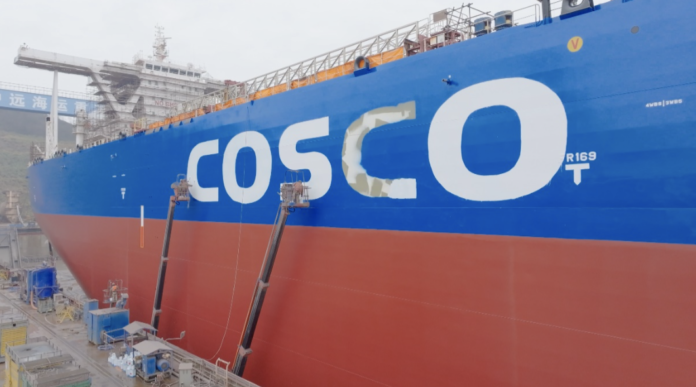PPG has completed the first drydocking project for COSCO Shipping Energy Transportation using the electrostatic application of its PPG SIGMAGLIDE® fouling release coating.
The project was carried out on the Yuan Chun Hu, a 333-meter crude oil tanker owned by COSCO Shipping, at the Liuhengdao shipyard in Zhoushan, China. The vessel’s underwater hull was coated with PPG Sigmaglide 2390, while the boot-top received PPG NEXEON™ 810 antifouling coating.
As the operator of Asia’s largest tanker fleet, COSCO Shipping is actively exploring innovative low-friction hull coatings to align with its greenhouse gas (GHG) emissions reduction goals under the International Maritime Organization’s (IMO) energy efficiency (EEXI and EEDI) and carbon intensity (CII) regulations.
“Ship owners and shipyards are being encouraged to look for innovative solutions to comply with stricter environmental regulations and meet their sustainability goals,” commented Xia Lei, PPG business director, Marine Asia Pacific, Protective and Marine Coatings. “Our premium hull coatings suitable for electrostatic application can help to reach these targets.”
PPG Sigmaglide 2390 is a biocide-free coating designed to help vessels cut power consumption by up to 20% and lower GHG emissions by up to 35% compared to conventional antifouling coatings.
These advantages come from PPG’s HYDRORESET™ technology, which creates an ultra-smooth, nonstick surface that prevents marine organisms from adhering. Meanwhile, PPG Nexeon 810 is an ultralow-friction antifouling coating that can contribute to an overall GHG emissions reduction of up to 25%.
Both coatings are compatible with electrostatic application, a technique PPG introduced to the shipping industry just over a year ago. This process electrically charges paint particles, guiding them precisely toward the vessel’s grounded surface. The result is an exceptionally uniform and smooth coating layer with improved durability.
Electrostatic application also enhances sustainability by increasing transfer efficiency compared to traditional airless spraying, significantly reducing overspray and waste. Additionally, when combined with the low volatile organic compound (VOC) emissions of PPG Sigmaglide 2390, the technique creates a safer and more environmentally friendly working environment for applicators.







